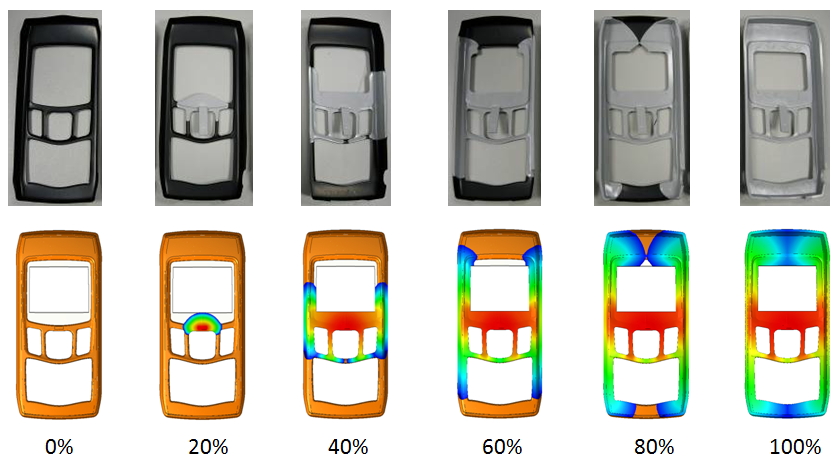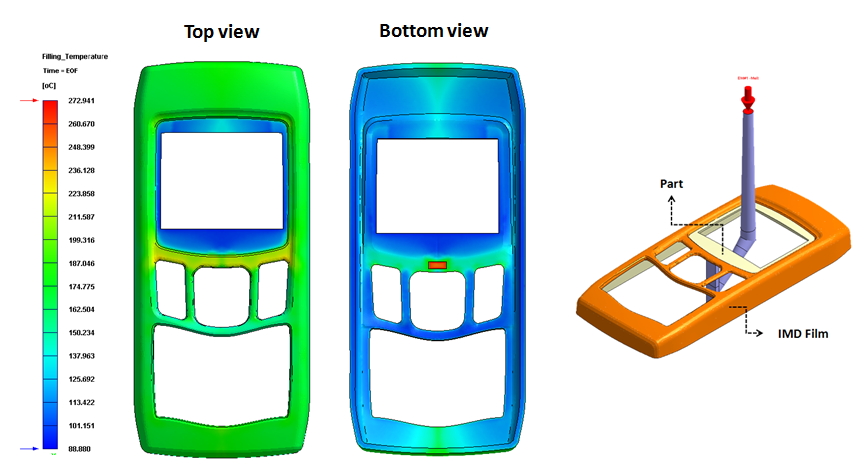The printing technology is widely applied in multiple industries. Apart from general paper printing, it is utilized in the manufacturing of laptop shells, mobile phone panels, circuit boards, LCD panels, automotive dashboards and daily necessities. The materials for printing include plastics, metal, glass and ceramics. In the past plastic product manufacturing, secondary processing such as plating, spraying and printing are required. Along with the increasing market demands in recent years, In-mold Decoration (IMD), a brand new plastics decoration technology is developed. It is the combination of printing and injection molding technologies, enabling the injection molded parts to be resistant to friction, scratch and corrosion. Furthermore, IMD products will possess exquisite colors and aesthetics.
Two common manufacturing issues of IMD process are ink washout at filling stage and product warpage or distortion due to uneven cooling at cooling stage. Thus, it usually requires many design iterations and would be time-consuming.
To solve the above problems, users can predict the in-mold dynamics through CAE simulation tools and optimize the product design according the analysis results. In order to attain more accurate in-mold decoration simulation results, Moldex3D has strengthened its capabilities in R15, the latest version software. It can now attain more accurate simulation result of the in-mold thin film temperature distribution, and then simulate the filling temperature and velocity vector field. It can also predict ink washout based on the product’s geometric properties. By analyzing the temperature field of IMD process, users will be able to attain a better understanding of the mold temperature changes, cooling and volumetric shrinkage behaviors. According to these analysis results, users can then reduce product warpage and molding defects, and furthermore optimize product designs. In addition, Moldex3D exclusively supports boundary condition options in pre-processing procedure. It enables users to efficiently and easily process the mesh layer of decorative pieces. Also, the new “Wash-out Index” feature enables product designers to accurately predict washout and ensures high-quality IMD products.
In the IMD case below, the product’s set mold temperature is 80℃, and the melt temperature is 240℃. As shown in Fig. 1, the simulated melt front is consistent with the experimental results. Next, we examine the temperature changes of the interface between the model and the IMD surface. Obvious heat hesitation is observed (Fig. 1), and the reason is poorer heat conduction of the decoration layer.
 Fig. 1 The melt front time comparison between the simulated and experimental results
Fig. 1 The melt front time comparison between the simulated and experimental results
 Fig. 2 The mold temperature distribution analysis of the IMD mold
Fig. 2 The mold temperature distribution analysis of the IMD mold
Since the IMD process include product surface processing and coloring procedures, many factors that occur in the mold could lead to product defects. Thus, users need to comprehensively understand the in-mold dynamic behaviors in order to avoid defective products. Moldex3D’s new simulation capabilities cannot only meet the above demands, but also help tedious trial-and-error process, accelerate product innovation, and significantly reduce manufacturing time and costs.